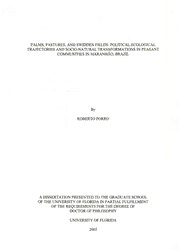
Palms, pastures, and swidden fields : political ecological trajectories and socio-natural transformations in peasant communities in Maranhão, Brazil PDF
Preview Palms, pastures, and swidden fields : political ecological trajectories and socio-natural transformations in peasant communities in Maranhão, Brazil
PALMS,PASTURES,ANDSWIDDENFIELDS:POLITICALECOLOGICAL TRAJECTORIESANDSOCIO-NATURALTRANSFORMATIONSINPEASANT COMMUNITIESINMARANHAO,BRAZIL By ROBERTOPORRO ADISSERTATIONPRESENTEDTOTHEGRADUATESCHOOL OFTHEUNIVERSITYOFFLORIDAINPARTIALFULFILLMENT OFTHEREQUIREMENTSFORTHEDEGREEOF DOCTOROFPHILOSOPHY UNIVERSITYOFFLORIDA 2002 Copyright2002 by RobertoPorro ToNoemi,FelipeandPedro ACKNOWLEDGMENTS IreceivedfinancialsupportfordoctoralstudiesattheUniversityofFlorida(UF) fromtheNatureandSocietyprogramoftheWorldWildlifeFund,Brazil (aprogram sponsoredbyUSAIDandtheStateUniversityofNewYork);theCollaborativeResearch NetworkprogramoftheInter-AmericanInstituteforGlobalChangeResearch(LAI);the Inter-AmericanFoundationFieldResearchFellowshipfordoctoralstudents;theTropical ConservationandDevelopmentProgramattheCenterforLatinAmericanStudies,UF; andtheComptonFoundation,throughtheProgramofStudiesinTropicalConservationat UF.Myspecialthanksgototheseinstitutionsandtothestaffassociatedwiththem. Iexternmysinceregratitudeforthetheoreticalandmethodologicalsupport,and fortheconstantencouragementprovidedbymysupervisorycommittee,withwhomI learnedandsharedideasduringtheresearchandwritingofthedissertation:Dr.Anthony Oliver-Smith,Dr.CharlesWood,Dr.MarianneSchmink,Dr.MichaelHeckenberger,Dr. MichaelBinford,andDr.EmilioMoran.ExtensivethanksgotoDrs.PeterHildebrand, H.RusselBernard,StephenPerz,NigelSmith,andTerryMcCoy.IalsothankKaren Jones,PatriciaKing,MargaritaGandia,JoeSavastano,andthestaffattheAnthropology Department,andattheCenterforLatinAmericanStudies,UF. IamdeeplygratefultothefamiliesofJoseSoares,MiltonMonteiro,andlido Lopes,wholetmestayintheirhouseseverytimeIvisitedLagodoJunco.Ratherthan theproductofisolatedfieldresearch,thisdissertationistheresultofmorethanadecade ofcloseworkwithpeopleintheMearimValley.Therefore,Iwouldliketoextendmy IV thankstoRaimundoVital,RaimundoHerminio,FranciscoMarcelino,JosedeBrito,Jose MariaCameiro,ManoelRodrigues,ManoeldeFranqa,FranciscoLima,MariaAdelina, MariaAlaides,AntoniaBrito,andLeonicePereirafortheprivilegeoflearningfromthe struggleoftheirlives.IamgratefultopeopleworkingatASSEMA,andparticularlyto LucieneDias,JaimeConrado,CarolinaMendes,ValdenerMiranda,JoseCarlos Florencio,RonaldoCameiro,FrancinaldoMatos,TeresinhaAlvino,andIldethSousa. IamgratefultothePrefeituraofLagodoJuncoforprovidingvaluable information.IthankMarildoSousa,MauricioFerreira,AgenorNepomuceno,andArlan Silvaforthefieldapplicationofsurveyquestionnaires;andAdrianafortranscribing interviews.Fortheirhelpinthegenerationofmapsandotherdocuments,IthankJim SloaninthecartographiclaboratoryatUF’sGeographydepartment;andHenriqueMota andFranqois-MichelLeToumeau,inBrazil.IalsothankGlenGreenforhishelpwith remotesensingprocedures.Formorethan15yearsofwork,supportandfriendship,I thankAlfredoWagnerdeAlmeida.1amalsogratefultoKayePyle,AnthonyAnderson, PeterMay,JorgeZimmerman,andRobertWilson,whowerecloseadvisorsinthe transitionbetweenworkinMaranhaoandstudyandresearchinGainesville.Ialsothank JoaquimShiraishi,KarlWirtz,Jean-FranqoisTourrand,DomingosDutra,Adolfo Themme,EribertoRembecki,andKlausFinkan. IgratefullyacknowledgethesupportofAntonioandAdaPorro,Eugenio Caffarelli,andShiroandKazucoMiyasaka.Noemisharedwithmecollege,work, graduatestudies,lifeexperiences,challenges,frustrations,andrealizations.Ithank NoemiandourchildrenFelipeandPedrofortheeverydaylessonsIleamfromthem.I alsoaskthemtoforgivemymistakesalongthistrajectory. v PREFACE ThemotivationstowriteontheeventsandprocessesthatoccurredinLagodo Juncogobacktotheonsetofmyprofessionalcareer,andexpressanattempttoputa capstoneon15yearsofsharedexperienceswiththepeopleandplacesthataremuch moretomethanresearchsubjectsandresearchsites. MyintroductiontoLagodoJuncowasin1986.Withabackgroundinagronomy, Ibegana3-yearcontracttoassistpeasantcommunitiesthathadrecoveredtenurerights previouslyerodedinthewakeoflandconflictsthatoccurredsincethe1970s.Asitturned out,IlivedintheMearimValleyfor8years,mostofthattimeworkinginLagodo Junco,themunicipalityIreturnedtoeveryyearsince1996tocarryoutresearchonthe interplaybetweensocioeconomicandbiophysicalchange.Inthecourseof15yearsof livingandworkingclosetothepeopleofSaoManoel,PauSanto,andothervillages,I witnessedfirsthandthestrategiesadoptedintheirdailystruggletoovercomeinternal differences,todealwithstructuralconstraints,tocopewithrestrictionstoaccessto resources,andintheirstruggletosurvivethethreatstothebasisoftheirlivelihood.That experience,inturn,hadaprofoundinfluenceonmysensitivitytoandappreciationofthe complexityofpeasantsocialsystems.Theexperiencealsohighlightedtheneedtofurther understandthedynamiclinksbetweenfeaturesofthelandscape,andprocessesthat influenceland-usestrategies,andsocioeconomicstratification. ImovedwithmywifeNoemiandsonFelipetoMaranhaoinJune1986.1was22 atthetime,havingrecentlygraduatedinAgronomyattheUniversityofSaoPaulo.Ihad vi noworkingexperienceinthefield,exceptforajobIheldintheprevious10months, whenImanagedadairyfarminthestateofMinasGerais.Thefarmwasownedbya familymemberwhohadrecentlyenteredintotheventure.However,overseeingastaffof halfadozenlaborerstoupgradeandmakeprofitablethoseseveralhundredhectareswas notexactlywhatIanticipatedforaprofessionalcareer.Myundergraduatestudies focusedonruralsociologyandagrarianissues,andIexpectedtoengageinprogramsor initiativesthatpromotedlanddistribution.AsBrazilhadjustenteredthetransitionto democracy,expectationsabouttheimplementationofland-reformpolicieswereonthe rise.Eventhoughthejobonthefarmwasconvenient,andfosteredthebeliefthatIwas providingsupportformyfamily,theideaoftakingapositionoverseeingateamof practitionerswhowereassistingpeasantcommunitiesintheirstruggletoadjusttoanew resourcebasewasachallengetoNoemiandme. TheprospectofworkinginMaranhaowasparticularlyattractivebecauseitwas preciselythestatewehadvisitedin1983and1984andhadchosenasafuturelocationto settledownandstartalifetogether.Earlyin1986,theDioceseofBacabalincentral Maranhaoannouncedasearchforanagronomisttodirectateamofagricultural technicians.Thedutiesweretoassistpeasantcommunitiesthathadrecentlysuffered violentdispossessionfromthelandstheyworked,andwerethenintheprocessof recoveringtheirtenurerights.UponmeetingwiththeprojectdirectorinSaoPaulo,we agreedtoashortinitialvisittotheprojectregion.Duringa1-weekvisitinMarchofthat year,Ihadtheopportunitytoattendoneofaseriesofgatherings(encontros)ofleadersof thosecommunities.ThistookplaceinthecityofBacabal,wheretheyplannedacommon strategyandproducedareporttobedeliveredtostateauthorities.Thearticulate vii narrativesexpressedbythose40peopleimpressedmefromthestart,givingfleshand flavortodiscoursesandinformationIhadpreviouslyreceivedonlysecondhand. ThegatheringinBacabalwasmyfirstopportunitytocontactactivistleadersof localruralworkers’movements.DuringthemeetingIaskedpermissiontovisitseveral villagesinLagodoJunco.MyvisittothecommunityofPauSantowasanevenmore strikingexperience,andturnedouttobethekeytomydecisiontotakethejob.Having justreadMarioVargasLlosa’s“TheWaroftheEndoftheWorld,”thevividaccountsof PauSanto’sresidentsconjuredcountlesssimilarities,therebyputtingintohistorical perspectivetwoverydistinctcontexts—therestrictionsimposedonLagodoJunco’s peasants,ontheonehand;andtheassaulton19thcenturylibertariansfromCanudos,on theother.InthefewdaysofmyfirststayinPauSanto,Itouredthevillageandits surroundings,observinglocalland-usepracticeswhilelisteningtothenarrativesofBrito, Milton,Dade,andotherresidents.IwastoldaboutthepolicebrigadethatassaultedPau Santointhewinterof1985,shootingtodeathanelderlymanatthevillage’sentrance. Thegovernmentsoonterminatedthelandowner’spropertyrights,andthe1,000-hectare farmwasformallytransferredtothefederalgovernmentfortheimplementationofa land-reform/settlementprojecttobenefitlocalresidents.ThedramaticeventsIwitnessed thenpromptedthedecisionthatprofoundlymarkedthenextdecadeofmylife. NoemiandImovedfromtheBraziliansoutheasttoalocationinMaranhao, which,asitturnedout,wascompletelydifferentfromwhatweinitiallyhadinmind.Two yearsearlierwehadvisitedfishingvillagesnearthecoastalcityofAlcantara,acrossthe bayfromSaoLuis,thestatecapital.Instead,weendedupworkingandlivinginLagodo Junco,atownof2,500-peoplesurroundedbypasturesandpalms.Thetownwascentrally Vlll locatedwithinBacabalDiocese,andwasa10-minuteridefromLagodaPedra,alarger cityof25,000-people;andsiteoftheresidenceofGermanFranciscanfriars,oneof whomwasthedirectoroftheprojectinwhichIbecameinvolved.Byservingas coordinatoroftheagriculturalteamfortheACESAProject(ProjetoAqaoComunitariade EducagaoemSaudeeAgricultural,IcouldlivewithmyfamilyinahouseinLagodo JuncoownedbytheFranciscanfriarsthathadbeenvacantinthepreviousfewyears.The largestresidenceintown,thehousewasbuiltinthe1940sbythearea’smainpolitical chief.ItwassoldtotheChurchinthe1970s,anduntil1983wasusedtoeducateandtrain youngmissionaries.Forthenext3years,thehousewasourhome(whereoursecondson Pedrowasbom),headquartersoftheagriculturalproject,andlodgingsiteforproject membersandvisitors.ItwasalsowhereNoemiandIexchangedvisitsandmaintained rapportwithleadersoftheruralworkers’movementinthearea,whichwascriticaltoour acceptanceduringandaftertheperiodoflandconflicts.Thebuildingalsoservedasa focalpointtoformulateinitiativesdesignedtopromoteconservationandtherationaluse ofnaturalresourcesinsettlementareas. Intheyearsafter1986,whileNoemiparticipatedinaneducationalprojectinthe nearbytownofPoqaodePedras,Ihadtheopportunitytoworkandperiodicallyvisit dozensofpeasantvillagesthatexperiencedlandstmgglesinthemunicipalitiesofLago doJunco,SaoLuisGonzaga,LagodaPedra,Bacabal,PauloRamos,VitorinoFreire, LagoVerde,LimaCampos,andEsperantinopolis.In1989,thelocalCatholicChurch resistedtheemergenceofanautonomoussocialmovementwithinitsownstructure. NoemiandIthereforehelpedformanindependentalthoughmorerestrictedregional alliance.Organizedbythelocalruralunions(SindicatosdeTrabalhadoresRurais),the IX alliancewascomposedofleadersrepresentingover2000householdsinsome25 communitiesinvolvedinsettlementprojectsinLagodoJunco,SaoLuisGonzaga,Lima Campos,andEsperantinopolis.The1989foundingassemblyofASSEMA(Associagao emAreasdeAssentamentonoEstadodoMaranhao)tookplaceintheLagodoJunco house.Fromthenuntil1994weservedastechnicaladvisorsforthenewlyformed organization,whichoperatedoutofthecityofPedreiras.ASSEMAwasagrassroots movementaswellasaninstitutionthatprovidedtechnicalassistance,extension,and trainingservices. Initially,ASSEMAfocusedontheresolutionoflandconflicts,lobbying governmentagenciesforpeasanttenurerights,andmoreequitabledistributionof resources.Thisapproachwasgraduallybroadened,ontheonehand,byASSEMA’s initiativesconcerningproductionandcommercializationofagriculturalandextractive goods(mainlyrice,manioc,andbabassukernels)and,ontheother,byASSEMA’s organizationofwomenworkingwithbabassu.By1991,localsocialmovementsactivein theregionincludedassociationsofproducersinmostsettlementareasofthefour municipalities,anagroextractivecooperative,andanassociationofruralwomenworkers inLagodoJunco.Theconservationofbabassupalmswithinranches,andlocal populations’accessrightstothosestandsbecamethetrademarkprioritiesforthevarious institutions.Since1992,peasantsinLagodoJunco,SaoLuisGonzaga,and EsperantinopoliswereabletoelectmembersofASSEMAastheirrepresentativesinthe municipalities’legislative.Yet,ASSEMA’smainchallengewastofindanalternative productionsystemtomeettheneedsofhundredsofhouseholdsstrugglingtosurvivein theregion.Traditionalslash-and-bum,swiddenagriculturenolongermettheneedsof x
